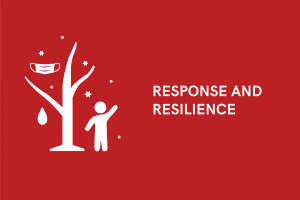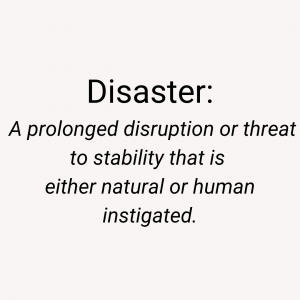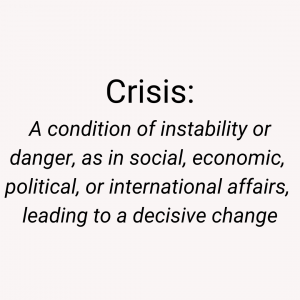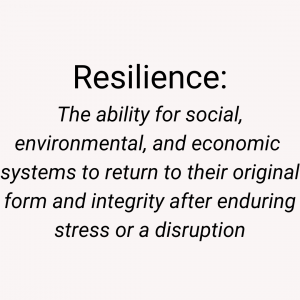Table of Contents
Introduction
Our world is increasingly inundated with catastrophes that impact our communities and our environment. The frequency and scale of natural disasters are rising with a warming planet, globalization, urbanization, and a growing population. This has been overlaid by the societal upheaval caused by the pandemic and the growing agitation around the global about racism and inequity. Added to this is the rising awareness of the threat of mass extinction. Disaster, in its various environmental, social, and economic manifestations, challenges our communities to respond effectively and sustainably. As the knowledge sector, higher education institutions (HEIs) are well-positioned to provide resources to communities in need and to develop and test solutions.
Building resilience is the key to combatting crisis. HEIs frequently have access to resources such as capital, infrastructure, and trained individuals. Perhaps more importantly, they can often lead innovation and provide the knowledge, creativity, or influence necessary to plan for or recover from a disaster. It is crucial that HEIs, especially research institutions, engage with every phase of disaster preparation, response, and recovery concerning both their campuses and the surrounding communities. Doing so will advance most of the SDGs, which across the board promote social, environmental, and economic priorities.
Since its emergence in the final months of 2019, the coronavirus has nearly monopolized the world’s attention. The sheer scale of the virus and its persistence in our population has redefined crisis in academic circles and more importantly, in the way the public understands it. Collaborative and innovative frameworks that have been developed to combat the pandemic will undoubtedly prove to be valuable as we tackle the other most pressing global emergencies, such as the climate crisis, the biodiversity crisis, and systemic injustice and racism. While the pandemic may dominate the conversation surrounding disaster response in the near future, this chapter showcases responses to a variety of crises, including natural disasters, emergencies, social upheaval, and environmental hazards.
Opportunities
Partnership for prevention and preparation
By collaborating with local community leaders and external emergency services, universities can educate the public and train their campus communities in disaster management. By sharing resources and knowledge with the surrounding community, HEIs can prepare for informed and coordinated emergency responses. Tangible outcomes of this work might include a trained task force, a course for the public on emergency response, or research on the best response strategies for a particular disaster. HEIs can also promote measures that also mitigate disaster and enhance the community. Some examples include green infrastructure and tree canopy projects which reduce flooding and heat island effect and improve access to natural spaces.
Crisis as a time to reevaluate systems
Crisis has three positive impacts on a community: First, they offer opportunities to reflect on values and resources, often prompting re-evaluation of “business as usual” in a city, organization, region, or even the greater world. Second, a major event can place a glaring spotlight on weaknesses in systems. Examining community action at the time of a disastrous event can reveal these shortcomings. Lastly, crises provide the impetus to think about prevention and progress. To avert a disaster means to consider the future, formulate a plan, and act on it.
Relief and support for the community
In the wake of a disastrous event, HEIs are looked to for relief and guidance by their students, employees, and surrounding communities. To be this beacon, universities must remain dynamic and quickly adjust to new conditions. Adaptation may mean a shift in attitude, a push to gather and disseminate new data, or a modification in a university’s framework for support.
Depending on the circumstances and resources, HEIs may provide shelter, space, food, clean water, personal protective equipment, physical and mental health resources, and any number of other resources to their communities. Setting up transparent and regular modes of communication is also critical in informing students, employees, and surrounding communities about available knowledge and resources, and therefore quelling panic. These can take the form of mediums such as informational hotlines, mass text messages, social media posts, and regularly updated crisis websites.
Driving theory to action
Universities are hubs of knowledge and innovation, but there is a gap between research and implementation. While students absorb the outcomes of research through their coursework, and therefore indirectly bring new knowledge and ideas with them when they graduate, this indirect form of transferal of ideas takes time and may lose saliency. HEIs conducting cutting-edge work on climate mitigation and adaptation, community building, health crisis response, and other topics pertaining to global priorities may consider how to make their most pertinent research accessible to policymakers, NGOs, and other stakeholders.
Hurdles and Solutions
The uncertainty of crisis
Hurdle: HEIs expect to follow protocol or guidelines in case of an emergency. However, as the COVID pandemic has demonstrated, it is not possible to anticipate all possible crises. The nature of a challenge may prompt fast rather than deliberate action, which may have unintended consequences.
Solution: While it is impossible to anticipate every possible crisis, there are opportunities to prepare for response and establish protocols that may be deployed to address multiple scenarios. A vulnerability assessment carried out by an emergency preparedness committee will help a campus to design a comprehensive list of potential scenarios and action plans for each. Planning promotes sustainability: a short-term response that does not accommodate for future disasters is not nearly as valuable as a well-considered, long-term plan. Sharing key concepts associated with this planning effort also has the potential to benefit the surrounding community and peer institutions.
Below are case studies submitted by IARU members which illustrate how their universities have responded to disaster and built resilience. They demonstrate tangibly how HEIs can have an impact on response and recovery in innovative ways while supporting the SDGs.
The compounding of crisis
Hurdle: A community dealing with a crisis may not have the economic and social resources and capacity to remain resilient, and a new challenge may lead to a cascade of crises. For example, the COVID-19 pandemic was overlaid with examples of police brutality and resulting global racial justice protests. HEIs that were already stretched thin need to respond to urgently to injustices, further drawing down resources.
Solution: To ensure appropriate allocation of limited resources, create a task force with diverse stakeholders who firmly understand the issues at play and are prepared to act. Divide and conquer the responsibilities of responding to each crisis amongst this group. Know the members of your community who are best-suited to respond to scenario types so expert perspectives can be added to the task force as needed. Be sure that the teams charged with tackling a specific challenge have the right platform and disseminate clear communications. It is also important to note that the systemic problems in a community are often interconnected, and therefore so are the solutions. As we tackle compounding crises, HEIs can design intersectional solutions that address multiple challenges at once, thereby supporting and strengthening the most vulnerable communities.
Below are case studies submitted by IARU members which illustrate how their universities have responded to disaster and built resilience. They demonstrate tangibly how HEIs can have an impact on response and recovery in innovative ways while supporting the SDGs.

University of Cape Town: Chronic Drought: Water crisis for a leading university on the tip of the African continent

The University of Tokyo: Addressing the Role of the University in Stewarding the Global Commons in the Anthropocene

Yale University: Advancing Intersectional Sustainability Work from Inside Out: Assessing the co-benefits of Yale University’s sustainability goals

Yale University: Integrating Intersectional Sustainability Work From Inside Out: Integrating Justice, Equity, Diversity, and Inclusion into Student Programming

The National University of Singapore: Creating a Well and Green Precinct, School of Design and Environment at the National University of Singapore
Quick Tips
- Speak their language. Clear and consistent communication with affected stakeholders is crucial to understanding the challenges they face and the best format in which the solutions should take. If you do not have a relationship with affected stakeholders prior to a crisis or event, ensure that representatives from these groups are included in decision making processes.
- Turn inward. When a crisis arises, it is easy to become overwhelmed by the scale of the issue and immediately look to big-picture solutions. Begin by reflecting on the ways that your institution – or even individual offices within an institution – internally contributes to systemic problems and resilient solutions in your everyday operations and culture.
- Team up. In the face of a crisis or disaster, gathering an interdisciplinary taskforce of partners and stakeholders can help address compounding crises and ensure a quick and equitable response.
- Look back to move forward. In the aftermath of a crisis or disaster, reflect on the successes and challenges of your institution. Do not return to solutions, plans, or infrastructure that were insufficient, inequitable or costly. Use learnings to build back stronger.
- Plan ahead. Before implementing a long-term solution, be sure that there is capacity and funding to maintain it for years to come. Determine who is responsible and accountable for up-keep and maintenance and establish clear lines of communication between these parties.



